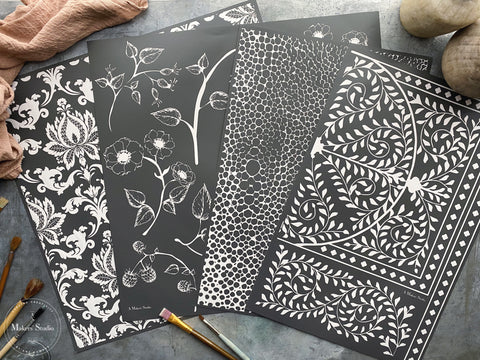Inside A Makers' Studio
Inside A Makers' Studio

How to Make Stencils At Home | Tips for Making Stencils DIY
March 06, 2023
How to Make Stencils At Home: Your Guide to Making Stencils DIY
Curious about how to make stencils at home? DIY stencil-making sounds good in theory, but we’ll show you a better way to bring your art projects to life with the help of stencils that saves you time and disappointment.
Is Making Stencils DIY Hard?
Making stencils DIY can be a great way to express creativity in crafting, painting and even baking. With the right materials and a little patience, creating customized, personalized stencils at home is an achievable task, though it is a very involved process. Making stencils DIY is a fun activity to get creative and make something unique, so don't be intimidated - give it a try!
What Material is Used to Make Stencils DIY at Home?
The most popular material for stencils is mylar or thick plastic. This makes for a durable stencils that can be used over and over, but it is not adhesive, so you will need to take care when painting that the edges are taped down to prevent bleeding.
Here are the supplies you will need to create your own DIY stencils at home:
- Mylar or transparent plastic sheeting
- Your chosen deign or pattern
- Exacto knife
- Cutting mat
- Ruler
- Low tack tape
- Sharpie or any fine tip marker
How to Make Stencils At Home: Step-by-Step Guide to Making a Stencil DIY
1. Pick a Design
You can find a pattern or design in Photoshop or other programs that offer clip art. You can also find designs online, just make sure to obtain these from royalty free sites. You can also hand draw your design freehand!
Once you've found your design, print it out in the exact size you want for your surface.
2. Trace
This is where the cutting mat comes in handy. Place the design on the mat and then add the mylar/plastic sheet directly on top. Line them up exactly corner to corner or edge to edge so they are straight. Once they are lined up, tape them down to keep in place.
Using a Sharpie or fine tip marker, trace your design onto the Mylar/plastic. Take your time and use a ruler for any straight lines. Press a little harder with the Sharpie or marker to help steady freehand lines.
Take your time when tracing. If you make a mistake, don't worry! Sharpie and marker can be removed very easily from Mylar with a Q-Tip and rubbing alcohol.
3. Cut it Out
This is a step to take your time with as well. You'll need to be very exact when cutting the design, as this will be your final stencil!
Once you've finished tracing the design onto the Mylar/plastic, remove the tape and the design underneath. Make sure that the blade of the Exacto knife is sharp and use a ruler for cutting any straight lines in your design. This works well if steady, even pressure is applied. Then you may pop out the cut pieces, being careful not to rip the Mylar when pulling away the cut pieces.
4. Start Painting
Once finished cutting out the entire design, your stencil is ready to use! Be sure to tape the stencil down to your surface and paint carefully as there is no adhesive on the back.
Save Yourself Time & Disappointment From Making Stencils DIY - Get the Best Mesh Stencils at A Makers' Studio!
If you're thinking about how to make stencils for a DIY project, save yourself time and potential disappointment by buying pre-made Mesh Stencils from A Makers' Studio! Not only will you get the perfect look and design that you need, but you'll also get a much higher quality product than if you were to make it on your own at home. Plus, A Makers' Studio Mesh Stencils are fully adhesive. You don't have to worry about taping down the stencil or bleeding lines. Mesh Stencils are also designed with intricate and beautiful details you can't possibly achieve when making yourself. You will be stunned with how easy it is to create stunning designs with no painting or crafting experience needed!
Making Mesh Stencils yourself can be a tricky process - especially if you don't have the right materials or know how - so leave it to the professionals instead. Take advantage of the great options available at A Makers' Studio and make sure your next DIY project is done right!




Why Our Stencils Are the Best Way to Create Your Art
A Makers' Studio Mesh Stencils are the perfect way to create beautiful art quickly and easily. Whether you have no experience with crafting or are a veteran artist looking for something new, Makers' Studio has hundreds of designs in multiple sizes and easy-to-follow instructions that makes creating your masterpiece effortless. With easy access to stencils, novices can look like experts in no time and artisans can mix it up and create something revolutionary. Plus, Makers' Studios Stencils are easy to find online so you can get creative right away!
These thoughtfully designed and patented Tri Mesh adhesive stencils can be combined with a variety of surfaces to create endlessly customized DIY home décor.
What you'll love:
- Create beautiful stenciled words and imagery for any occasion!
- Use over and over again on almost any surface and with almost any finish, from One Step Paint to ChalkArt and even gilding.
- New and improved design features stronger adhesive, easier cleaning, and simpler transfer between different surfaces.
Grab your favorite stencil designs and start adding artistic elements to your furniture and accents without any drawing or painting skills!

No Matter What Project You Have in Mind, We Have a Stencil For That!
When it comes to tackling a DIY project, it can be hard to find the right tools for the job. Whether you’re creating a sign for your home, painting a mural in your office or working on a craft project with the kids – you need the proper supplies and materials to make it stand out. That’s where A Makers' Studio come in! Our stencils make it easy to get precise and perfect results every time. With many sizes, shapes and designs to choose from – there is something for everyone no matter what project is at hand. Plus our stencils are super simple to use – so even total beginners can jump right into their creative projects without any prior experience. So don’t worry about struggling through your next project or making your own DIY stencils - we’ve got you covered with a stencil that fits every need!
- Quote Stencils
- Animal Stencils
- Bible Verse Stencils
- Holiday Stencils
- Pattern Stencils
- Letter Stencils
Closing Thoughts on How to Make Stencils At Home
Home-made stencils are a DIY adventure, but can be time consuming and prone to mistakes. You could lose hours of your time and end up with uneven lines or a mishap in design. Creating your own stencils is a fun way to take your crafting skills to the next level, but if you're looking for a quicker and easier way to immediately being crafting, Mesh Stencils from A Makers' Studio is the way to go. You'll get amazing results every single time. Designed and manufactured by experts in the industry, they feature intricate detailing, precision cut lines, and top quality material that lasts through repeated use. So skip the frustration of making a stencil at home and trust A Makers' Studio to handle all your stenciling needs.
Check out our hundreds of designs, pick your favorites, and get started Crafting Your Beautiful Life!
Check out these related articles for even more help and inspiration:

How to Paint Stencils On Wood | Best Way to Start Painting Stencils on Wood
March 06, 2023
Looking for the best way to go about painting stencils on wood? Our guide on how to paint with stencils on wood covers everything you need to know - including the best paint to use and how to limit bleeding!
Whether you are an experienced painter, a beginner crafter or just wanting to add some personality to your home décor, learning how to paint stencils on wood can be a fun and creative project. Stenciling is one of the best ways to create beautiful elements for your walls, furniture or other projects while still keeping the look intricate and clean. With the right materials and supplies, anyone can master this craft! This blog post will guide you through all the steps necessary in order to confidently turn stenciled art into wall-worthy pieces that provide style and value. Learn different techniques on how you can use painting with stencils on wood such as adding texture or layering colors, plus see examples of finished projects that spark your inspiration. Let's get started!

How to Paint Stencils On Wood Without Bleeding: The Best Way to Start Painting Stencils on Wood
Painting with stencils on wood can be an exciting craft project for anyone who loves arts and crafts. To maximize your artistic designs, it's important to take the steps necessary to ensure that your paint does not bleed underneath or around the edges of the stencils you are using. Taking different measures before painting with stencils on wood will guarantee you a professional-looking project in no time! To make sure your paint doesn't bleed, prepare your surface by cleaning it with the A Makers' Studio Clean Slate and making sure the surface is clean of all debris, dust, dirt, and grease. You may use a damp lint free rag if the surface is fairly clean already, but Clean Slate is best to remove grease and dirt that may not be visible. If there are any holes in your wood surface, fill them with wood filler and sand lightly once dry, thoroughly wiping away any particles. If there are any rough spots or edges on your wood surface, lightly sand those also and wipe down well once finished. It is also very important to use light coats of paint rather than thick layers so they don't create pools that could cause paint to seep beyond the perimeters of your stencils. A Makers' Studio Mesh Stencils are very finely detailed so there is no need to use a great deal of paint. Thin coats is best! Some wood surfaces will have a coarse grain which means the pores of the wood are wide set while some wood will have a fine grain which means the pores of the wood are very close together and smooth. A fine grain is ideal for painting with stencils on wood as this allows the stencil and paint to best adhere. If the wood surface you choose to use does have a coarse grain, don't worry! All you need to do to even the surface a bit is add a coat of paint before stenciling. The A Makers' Studio One Step Paint is best for painting wood and will be a great base for stenciling with additional mediums. Lastly, spray a topcoat of sealer over the final product to preserve its beauty. Following these simple steps will help you create vibrant projects without bleeding edges when using stencils on wood!

Is Painting Stencils on Wood Easy?
Painting stencils on wood is a fairly easy task, depending how you approach it. With the right tools and techniques, anyone can create beautiful artwork on wood with the help of stencils. Preparing the surface of the wood by sanding and priming it is key to achieving a crisp painting job. For best results, one should use two thin coats of paint, allowing each layer to fully dry before applying the next. This will help to achieve clean lines around the edges so that your stenciled image stands out nicely against the rest of the piece. Whether you’re a beginner or an experienced painter, learning how to paint with stencils on wood can be quite enjoyable and rewarding!
How to Paint Stencils on Wood Without Bleeding: Step-by-Step Guide to Painting Stencils on Wood for the First Time
Painting with stencils on wood can be a fun and creative way to customize your wooden furniture, walls, or accessories. However, if you're new to the process, it can be intimidating! To make sure your design looks great, follow this step-by-step guide to learn how to paint stencils on wood without bleeding.
Choosing the Right Stencils for Painting on Wood
A Makers' Studio provides some of the best and most finely detailed stencils perfect for creating designs on almost any surface. Create beautiful stenciled words and imagery for any occasion. Use over and over again on almost any surface and with almost any finish, from One Step Paint to ChalkArt and even gilding. New and improved designs feature stronger adhesive, easier cleaning, and simpler transfer between different surfaces.
Grab your favorite stencil designs and start adding artistic elements to your furniture and accents without any drawing or painting skills! Check out the various categories of Mesh Stencils below:
- Quote Stencils
- Animal Stencils
- Bible Verse Stencils
- Holiday Stencils
- Pattern Stencils
- Letter Stencils
What is the Best Paint for Stencils on Wood?
Painting with stencils on wood is an excellent way to create unique, artful projects for your home or workplace. However, the wrong type of paint can lead to a disappointing and unsightly outcome. Fortunately, there are many paints available that are designed specifically for wood-stenciling projects. One Step Paint is perfect for achieving the classic chalky finish popularized in Paris Flea Market shops. Gel Art Ink is another great option and provides a rich, permanent color ideal for fabric, apparel, and other soft surfaces as well as wood. ChalkArt paste is a removable medium that creates beautiful designs on glass, wood, and all kinds of surfaces. while Gilding and Gold Leaf offers a bright and elegant finish perfect for accentuating those special pieces of furniture. With all these options to choose from, you're sure to find the right paint for your next stenciling project on wood!

How Do You Get Clean Lines When Stenciling on Wood?
Painting stencils on wood is a great way to add some personal flair to furniture or home décor items. To ensure the best results, some preparation is necessary. Start by sanding your surface if it has any rough spots. If your wood surface has a coarse grain, you may need to add a layer of paint to smooth out the surface and ensure the smoothest adhesion. When applying your stencil to the surface, burnish it well with a ChalkArt Spreader or Squeegee to be sure that all the fine details are correctly adhered to the surface. When you are ready to paint, apply thin coats of paint rather than using thick coats for more even coverage and crisp lines. A little goes a long way! With these steps in mind, you will have beautifully painted wood items that look like they were made by a professional.
Wrapping Up Our Guide on How to Paint With Stencils on Wood
We understand that stenciling on wood can be a bit intimidating. However, it doesn't have to be with the right supplies and technique! We've gone into detail throughout this guide on how to best prepare your wood surface, the importance of a good stencil, the best paints and brushes suitable for the job, as well as helpful tips that will ensure your project turns out beautifully. With these few notes in mind, you'll have it made conquering your next stenciling project. So pick up your supplies and simply follow our elaborative instructions--you’ll soon realize that achieving decorative artwork with stencils on wood is actually quite easy. There's so much opportunity for creative expression when you’re painting with stencils on wood—it’s hard not to love something you created from nothing! With just a few tools and sound advice from us, you will reap fantastic results ready for display in no time. Don't just take our word for it - now you can go get started right away and experience what it feels like to paint on wood using stencils yourself!
Check out all the amazing designs and stencil sizes we have available:
Check out these related blogs:
- What Are Stencils?
- How to Paint with Stencils
- Best Stencils for Painting
- How to Clean Stencils
- How to Make Stencil Art





How to Clean Stencils | Why Cleaning Stencils is so Important
February 08, 2023
How to Clean Stencils: Tips for Keeping Them in Tip-Top Shape
If you're a maker or artist, chances are you've used stencils at some point. While they make it easy to create intricate designs with sharp lines and crisp edges, the one downside is that they need to be cleaned after use. But how do you clean stencils? We’ll talk about why cleaning stencils after use is so important in the first place and give you tips for washing yours. Let’s start by talking about why it's necessary to clean them.
Never heard of Mesh Stencils?
These thoughtfully designed and patented Tri Mesh adhesive stencils can be combined with a variety of surfaces to create endlessly customized DIY home décor.
What you'll love:
- Create beautiful stenciled words and imagery for any occasion!
- Use over and over again on almost any surface and with almost any finish, from Rescue Restore Paint to ChalkArt and even gilding.
- New and improved design features stronger adhesive, easier cleaning, and simpler transfer between different surfaces.
Grab your favorite stencil designs and start adding artistic elements to your furniture and accents without any drawing or painting skills!
Check out all the A Makers' Studio Mesh Stencil designs here!
Do You Have To Clean Stencils After Use?
Yes! Cleaning your stencils after every use is essential for keeping them in good condition and making sure they last as long as possible. Without proper cleaning, paint, ink, or other materials can dry on the surface of your stencil, which will make it harder to remove and can result in damage over time. Additionally, dirt and debris can build up on the surface of your stencil over time if it isn't properly cleaned after each use. This can lead to an uneven application when painting or drawing with your stencil and affect the accuracy of your image. Mesh Stencils are designed to give a crisp, clean design with intricate details, so cleaning your stencils is important to maintain that design quality.
Why Do You Need to Wash Stencils?
When it comes to cleaning your stencils, there are a few different methods you can use depending on how much time you have and what mediums you're using. For example, if you don't have time to wash your stencils immediately, then submerge them in a warm water bath to keep the paint from drying in the mesh. If you're able to clean your stencil immediately – then simply running it under warm water and messaging with your fingers should do the trick. Once all the residue has been removed from both sides of the stencil, be sure to lay it flat until it's completely dry before storing it away again. For ChalkArt, Gel Art Ink, and Ceramic Paints, using your hands and lukewarm water should do the trick.
For more heavy-duty applications such as One Step Paint or Gilding Size that may require more intense scrubbing action, try using a soft (wetted) sea wool sponge along with warm water and mild dish soap (such as Dawn) to remove any stuck-on residue without damaging the surface of the stencil itself. Just be sure not to press too hard and only scrub on the non sticky side so that you don't scratch any part of the design or compromise the adhesive of the stencil!
How to Clean Mesh Stencils
Here's everything you need to know step by step:
- While using a Mesh Stencil, you will want to complete your painting within a couple of minutes in order to prevent any paint from drying in the mesh of the stencil.
- Once you're done painting, carefully peel the stencil from your surface while the paint is still wet and immediately wash the stencil in warm water, rubbing the non adhesive side in circular motions with your fingertips until the mesh is clear of paint (you may also use a sea wool sponge to gently rub out the paint on the non adhesive side of the stencil). All our mediums are designed to pair with Mesh Stencils, but if the paint is not immediately washed out with your fingertips, you may place it in a warm water bath to loosen any paint. If you are not able to immediately wash the stencil, then you may go ahead and place it in a warm water bath until ready to wash (this is the best way to clean stencils if you're pressed for time or need to finish painting elsewhere).
- Once the paint is fully removed from the mesh, place your stencil adhesive side up to air dry. Do not ever lay adhesive side down to dry.
- After the stencil dries it can be pressed lightly back onto the white card stock surface it came on and returned to the plastic sleeve.






Additional Tips for Caring for Stencils
Beyond cleaning, there are other things you should keep in mind when caring for your stencil collection: always store them flat instead of folded; never leave them out in direct sunlight; avoid leaving them exposed outdoors; make sure they're completely dry before putting them away; and wash hands thoroughly before handling them (this helps preserve their accuracy). Following these steps will ensure that your collection stays neat and tidy while also keeping the designs clean and accurate over time!
Closing Thoughts on How to Clean Stencils
Tending our tools is part of being an artist—and taking care of our supplies means our art looks better every time we create something new! For this reason, proper cleaning techniques should always form part of our creative practice - after all, well-cared-for supplies mean better results every single time! Keeping our tools in good condition is key when it comes to creating beautiful artwork with maximum accuracy every time—and this goes double for art supplies like stencil collections. Taking a few moments to properly wash and dry your tools will save you time (and money) in future! With these tips for how to clean stencils in mind, we hope that you feel confident enough now to keep yours looking their best even after multiple uses!
Happy creating!

Want to see the process of cleaning stencils? Watch this short video!
Take a look at some of these most popular themed Mesh Stencils to get started making your very own projects!
Want to Enjoy the Bragging Rights? Join our community on the Crafting a Beautiful Life Facebook page to share project photos, get inspired, and get tips and tricks from fellow crafters.
We can't wait to see how you start Crafting Your Beautiful Life!
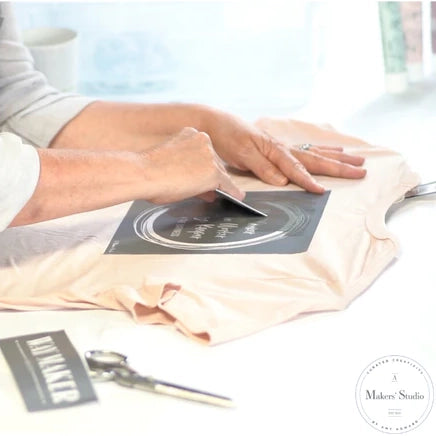
DIY Inspirational Shirt | Using Mesh Stencils
December 30, 2022
Imagine inspiring someone's life to be better just by going about your day with a great message printed on what you're wearing.
With a few tools from A Maker's Studio, you can do exactly that and turn simple, everyday shirts into joyful and inspiring pieces for everyone to see.
STEP 1: PICK A STENCIL AND A COLOR

Choose a reusable mesh stencil design that you like and a Gel Art Ink color to match.
For this project, we are going to use the Way Maker Mesh Stencil and Hold Your Horses - Gel Art Ink.
STEP 2: PREP YOUR SHIRT
Put a cardboard on the inside of the shirt you are working with.This will help make sure that the paint you are applying on either side of the shirt doesn’t bleed through the other.
STEP 3: APPLY THE STENCIL
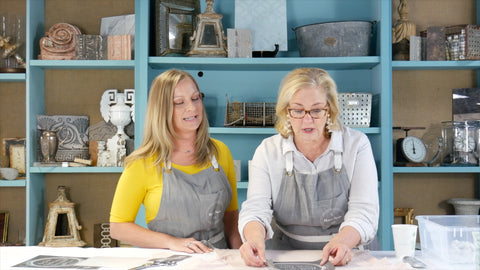
Remove its backing to expose the stencil's adhesive side and carefully place it on your shirt.
STEP 4: COLOR IT UP

Squirt some Gel Art Ink along one edge of your spreader. Hold your spreader at a 45-degree angle and spread the ink evenly over your stencil. Make sure that you are pushing the Gel Art Ink adequately through the mesh and onto the shirt.
STEP 5: LET IT DRY

When you're done, gently peel the stencil off and allow the ink on your shirt to air dry for at least two hours.
STEP 6: WASH YOUR STENCIL

Don’t let the ink dry on your stencil. Wash it right after use.
Place your stencil in water and use a clean rag to help wipe the ink off of it.
Then, take your stencil out of the water and lay it on a flat surface with the adhesive side up. Leave the stencil to air dry.
STEP 6: IRON THE PRINT

Place a lint-free rag on top of your design. Go over the rag with an iron for about 5 minutes. The heat is going to help the ink to set.
SOME REMINDERS:
If you get some of the Gel Art Ink on other parts of the shirt where you don't want it, wipe it off with a clean rag before it starts to set.After using your newly designed shirt, turn it inside out and wash it with cool water. Keep it out of the dryer to prevent the design from fading quickly.
If you need to use a dryer, use the cool setting and keep the shirt turned inside out.
Start spreading joy and inspiration today using these products:
Mesh Stencil - Way Maker
https://www.shopamakers.com/products/mesh-stencil-way-maker-8-5-x-11
Gel Art Ink - Hold Your Horses
https://www.shopamakers.com/products/gel-art-ink-hold-your-horses

Fun Fall DIY
September 09, 2022
The perfect cutting board for the upcoming FALL season. This stencil will create a fabulous background on any surface. Watch Lianep from DIY Beauty on Purpose as she takes you step by step on this fun DIY decor!
Products Needed:
Additional Supplies:
- Masking Tape
- Scissors
HOW TO

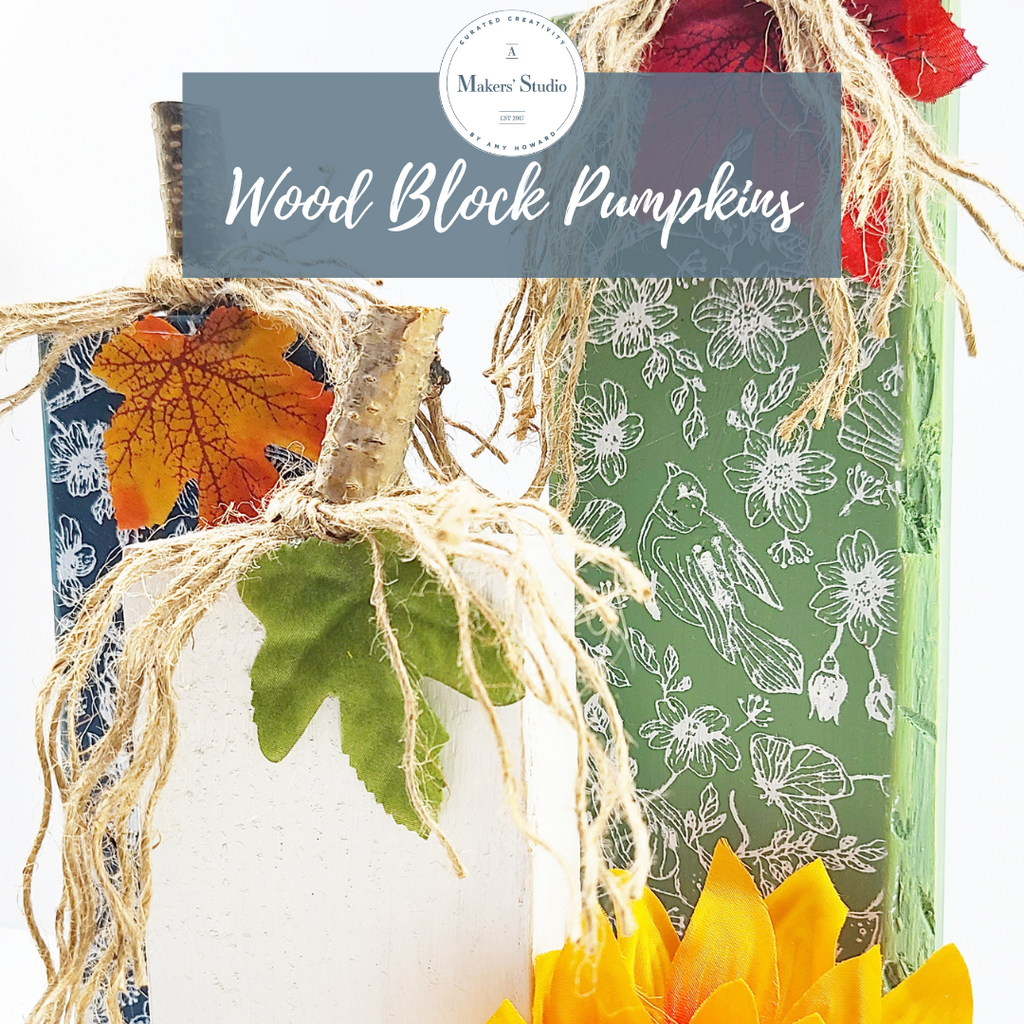
How To: Wood Block Pumpkins
August 23, 2022 2 Comments
It's (almost) fall y'all! We have fabulous new Mesh Stencil designs dropping for the season. Watch Lianep from DIY Beauty on Purpose use the NEW Birds and Buttercups Mesh Stencil to create wooden fall décor pieces. Don't miss it; we can't wait to see what you make!
Shop What She Used:
- Birds and Buttercups - Mesh Stencil
- Angled Squeegee
- English Boxwood - One Step Paint
- Midnight Dreams - One Step Paint
- Ballet White - One Step Paint
- Well I Declare - Gel Art Ink
Additional Supplies:
- Wood Blocks
- Short Wood Branches (for pumpkin stems)
- Jute or Twine
- Fall Leaves (fake or real)
HOW TO

For more fun tutorials and products, visit our blog at A Makers' Studio.com!
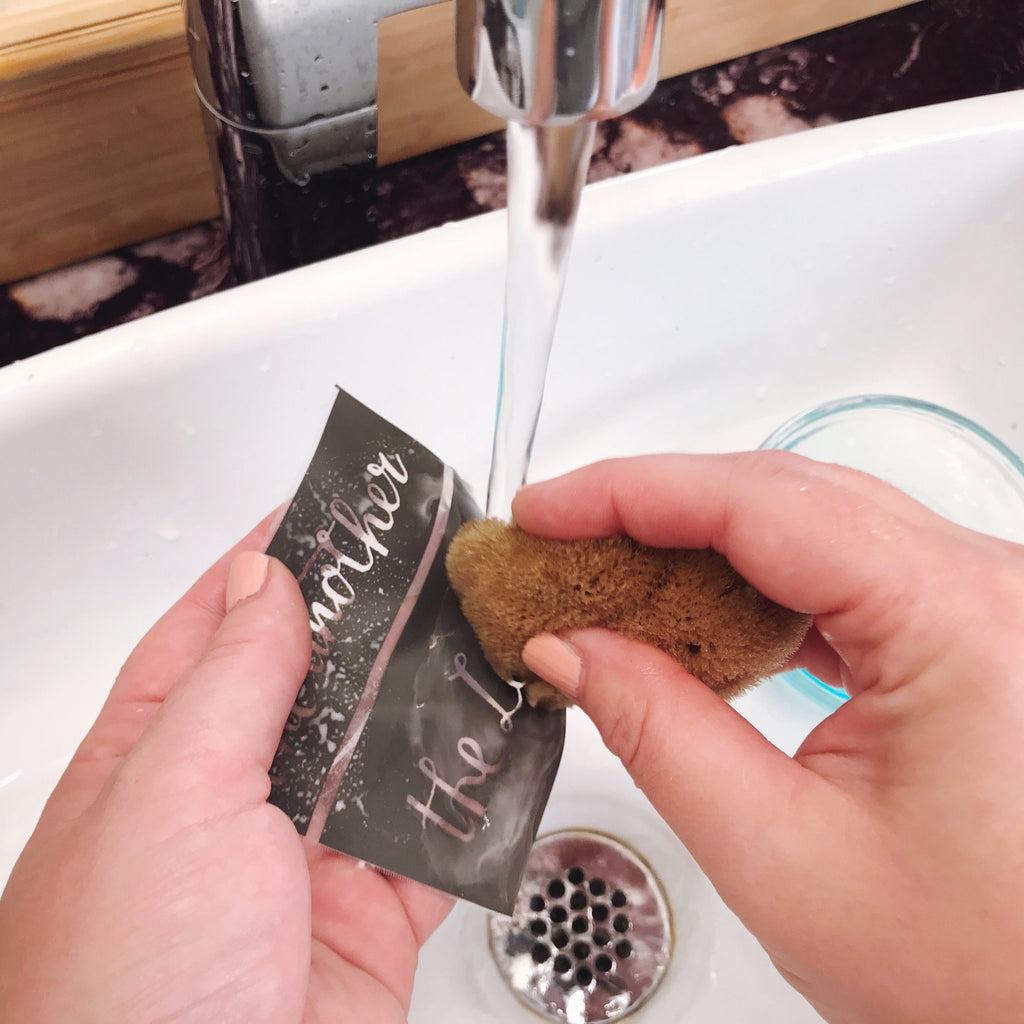
HOW TO CLEAN YOUR MESH STENCILS
August 05, 2020
WATCH THIS VIDEO TO LEARN HOW TO CLEAN YOUR STENCILS. YOU CAN USE YOUR STENCILS OVER AND OVER AGAIN WITH PROPER CARE.
FOR CHALKART, GEL ART INK, AND CERAMIC PAINTS - LUKEWARM WATER AND YOUR HANDS SHOULD DO THE TRICK.


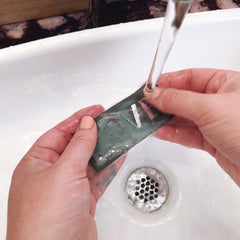
FOR PAINTS AND GILDING SIZE, YOU MAY WANT TO USE DISH SOAP AND A SPONGE.

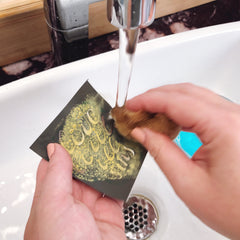

LASTLY, LAY STICKY SIDE UP TO DRY!


DIY TOWEL DIP DYEING
July 16, 2020
In this two-part tutorial, learn how to transform inexpensive, plain-looking tea towels into colorful items that are not just lovely to look at but can lift your spirits too.
These custom towels are great to use around your home or to give out as presents at any time of the year.
PART I: TOWEL DIP
STEP 1: PREPARE THE PAINT

This project uses Summer Nights - Rescue Restore Paint.
2 ounces of Rescue Restore Paint mixed with 20 ounces of water should be enough to color at least 3-4 tea towels.
STEP 2: DIP YOUR TOWEL

Hold your towel up and, coming from both sides, gather it towards the middle.
Dip half of the towel into the paint and let it soak up some color.
STEP 3: SQUEEZE OUT EXCESS PAINT
With one hand gripping the dry half of your towel, slowly pull the colored half out of the paint.Squeeze the excess paint out by letting the colored half of your towel pass through between the forefinger and thumb of your other hand.
Do this slowly to avoid splashing paint on yourself and make sure that your towel is not dripping with paint after this step.
STEP 4: MOVE THE PAINT
In another container with clean water in it, dampen the colored half of your towel.Use one hand to hold the towel up, with the colored half at the top.
With your other hand, squeeze your towel from top to bottom, helping the paint move downward, effectively covering the lower half of your towel with lighter shades of Summer Nights.
STEP 5: DRY YOUR TOWEL
Open your towel up and lay it on a piece of cardboard to dry.PART 2: STENCIL APPLICATION
STEP 1: PREP YOUR TOWEL
Lay your dry towel down flat.Have a cardboard underneath it to prevent ink from staining your work surface.
STEP 2: APPLY THE STENCIL

This project uses the Bless the Lord Mesh Stencil.Peel the backing off to expose the adhesive side and apply the stencil on your towel.
STEP 3: SPREAD YOUR INK

This project uses Hold Your Horses Gel Art Ink.
Squeeze some ink out along one edge of your spreader and apply the ink all over your stencil, holding your spreader at a 45-degree angle as you do so.
STEP 4: REMOVE THE STENCIL
Carefully peel your stencil off and rinse it right after use.Let it dry on a flat surface with the adhesive side up.
STEP 5: DRY AND HEAT-SET

Allow your towel to dry for at least 2 hours.
After which, heat-set your newly applied design. Place a lint-free rag on top of it and go over the rag with an iron for about 5 minutes.
Replicate this project and create your own customized tea towels with these products:
Summer Nights - Rescue Restore Paint
https://www.shopamakers.com/products/summer-nights-rescue-restore-paint
Mesh Stencil - Bless the Lord - 8.5x11
https://www.shopamakers.com/products/mesh-stencil-bless-the-lord-8-5-x-11
Chalkart Spreader
https://www.shopamakers.com/products/chalkart-spreader
Gel Art Ink - Hold Your Horses
https://www.shopamakers.com/products/gel-art-ink-hold-your-horses
Other Products Mentioned in the Video:
Gel Art Ink
https://www.shopamakers.com/collections/gel-art-ink
Goodness Gracious - Rescue Restore Paint
https://www.shopamakers.com/products/goodness-gracious-rescue-restore-paint
Mesh Stencil - Adventure - 8.5x11
https://www.shopamakers.com/products/mesh-stencil-adventure-8-5x11
Mesh Stencil - Birds - 8.5x11
https://www.shopamakers.com/products/mesh-stencil-birds-8-5-x-12

DIY GILDED SPOON REST
May 08, 2020
Products used for this project are linked at the bottom of the page.












- Angel Wings - Ceramic Paint
- Foliage - Clear Stamp (or any other Clear Stamp design you like)
- Gilding Size
- Pure Copper Leaf
- Foam Dome Brush
- Artist Brush
- Chip Brush

DIY CERAMIC FLORAL PLATES
May 04, 2020
Have you ever wanted incredible plate ware without that incredible price tag?
At A Makers' Studio, we're going to show you just how easy it is to craft your very own DIY ceramic dishes.
And the best part??
With our custom formulated Ceramic Paints, your DIY plate designs are food safe and washable!
DIY CERAMIC FLORAL PLATE INSTRUCTIONS
Step 1: Start by dipping your Artist brush into the gilding size and then using your finger to flick the size onto the plate.

Step 2: Once done, go back with your brush and carefully lift up any thick drops, maintaining the original shape of the splatter.

Step 3: Once the size has come to tack (it will appear translucent) you can apply the Silver Leaf.

Holding the spine with one hand, pull back the tissue with the other hand and lay the leaf down covering the area with size.
Step 4: After burnishing (pressing and rubbing down firmly) lift leaf packet up and continue the process until the entire plate is covered.


Step 5: Using a stiff brush, remove the excess leaf.

Step 6: Next, cut out sections of your Season stencil and place along the edge of the plate.

Step 7: Begin smoothing out any bubbles that are within the design, pushing them to the edges of the stencil.
Step 8: Next, place a dab of Black Ceramic Paint onto your Artist Brush and apply it to the stencil.


Step 9: Now carefully remove the stencil and immediately wash it with lukewarm water.

Step 10: Continue the process around the edge of the plate and onto another side.

Step 11: Once done, place in a cool oven and heat it to 325 degrees for 35 minutes. Turn oven off and allow it to cool inside the oven.
Step 12: Once cooled, place a dab of Tally Ho, Hot and Spicy, and Angel Wings on a piece of scrap cardboard and begin mixing together with your Artist Brush.

Step 13: Dip your brush into some water and then begin to paint in some of the flowers, just like paint by numbers.

If it is still too thick, you can dip your brush in the water again and mix it into the paint.
Step 14: Once you have added the coral color to desired flowers, go back and add a dab of Angel Wings to the mixture to create a lighter version.

Step 15: Begin applying it to the edges of each petal you have already painted with the coral color.
Step 16: Wash your brush off with water, then continue the process using the Smoke Got In My Eyes Ceramic Paint and any other combinations you like.

Step 17: Once done, place in a cool oven and heat it to 325 degrees for 35 minutes. Turn oven off and allow it to cool inside the oven.

NOW IT'S YOUR TURN TO CRAFT YOUR VERY OWN FLORAL PLATE DESIGN!
Here are the A Makers' Studio products used for this tutorial...
Ceramic Paint – Angel Wings
https://www.shopamakers.com/products/ceramic-paint-angel-wings
Ceramic Paint – Black
https://www.shopamakers.com/collections/ceramic-paint/products/ceramic-paint-black
Ceramic Paint – Smoke Gets In My Eyes
https://www.shopamakers.com/collections/ceramic-paint/products/ceramic-paint-smoke-gets-in-my-eyes
Ceramic Paint – Hot And Spicy
https://www.shopamakers.com/collections/ceramic-paint/products/ceramic-paint-hot-spicy
Ceramic Paint – Tally Ho
https://www.shopamakers.com/collections/ceramic-paint/products/ceramic-paint-template
Mesh Stencil – Season
https://www.shopamakers.com/products/mesh-stencil-season-12x18
Silver Leaf
https://www.shopamakers.com/products/imitation-silver-leaf-6-x-6
Gilding Size
https://www.shopamakers.com/products/gilding-size-2-oz?_pos=1&_sid=7d17260f8&_ss=r
Artist Brush
https://www.shopamakers.com/products/artist-brush
Chip Brush
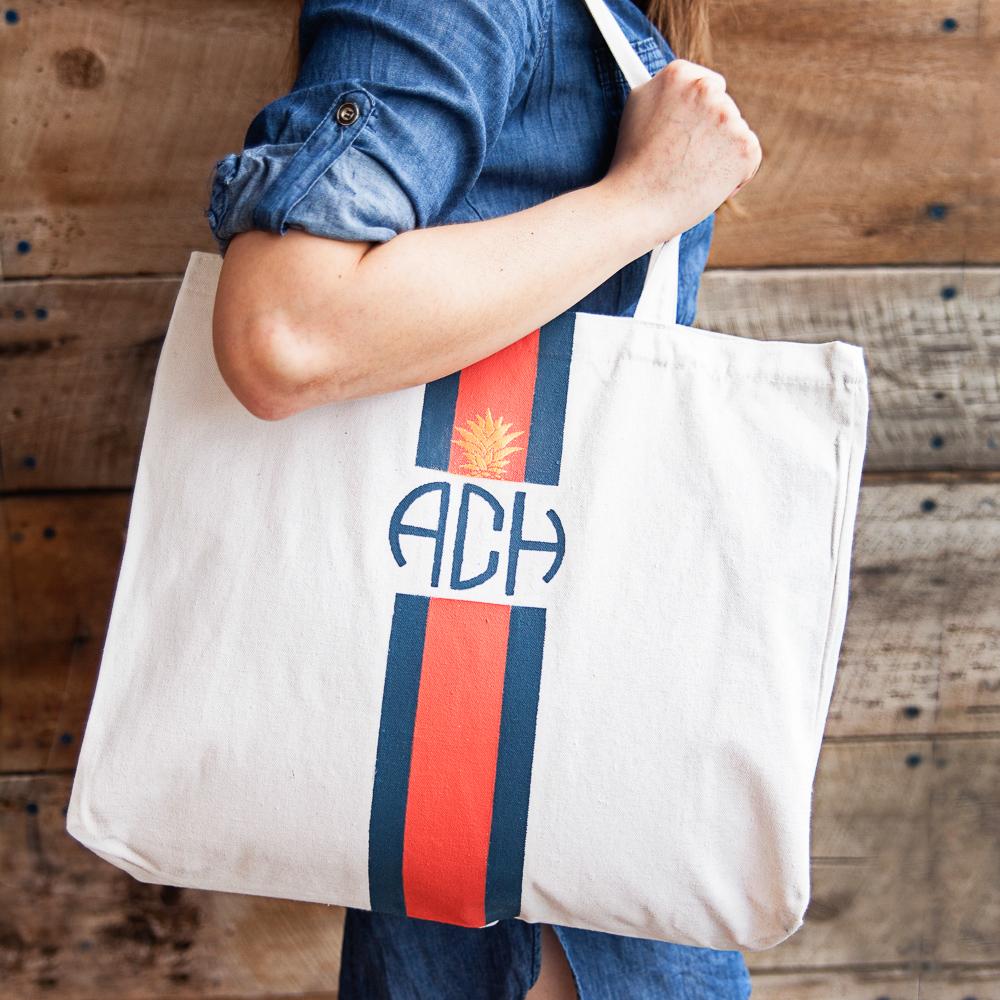
DIY MONOGRAMMED TOTE BAG
January 21, 2019
We all love super cute monogrammed tote bags, the ones that make a statement and can be used for virtually anything. But they cost so much more if you buy one from the store or a custom online shop… not to mention searching high and low for your perfect monogram design! We think everyone should be able to have a beautiful monogrammed tote bag, so today we’re sharing this fun and simple DIY monogrammed tote bag project.
MATERIALS NEEDED FOR YOUR DIY MONOGRAMMED TOTE BAG

- Your favorite 2 oz. Rescue Restore Paint
- A complimentary 2 oz. Rescue Restore Paint color
- Alphabet Monogram Stencil
- Foam Dome Brush 1.5”
- Masking tape
- A Makers’ Studio canvas tote bag
- Optional: Gold ChalkArt™
- Optional: Gilding Leaf for pineapple stencil*
* Pineapple stencil is included on the Alphabet Monogram stencil
HOW TO MONOGRAM A TOTE BAG
- Lay your tote flat on a surface, making sure to press out wrinkles or bumps.
- Choose the monogram for your initials and place them where you want them on the bag.
- Apply your first Rescue Restore Paint color to the first initial, making sure to apply an even layer to the fabric with your Foam Dome Brush. Let the first letter dry before applying the second and third. Repeat until all three initials are complete.

4. Wash your brush and the stencils, letting them dry thoroughly.
5. When letters are dry, lay out 2 strips of tape vertically across the tote, 1 1/2 inches apart. These vertical lines should align with your monogrammed initials.
6. Next, lay two pieces of tape horizontally across tote to protect the letters. These tape lines will also align with your initials and intersect the vertical tape lines.

7. Use the Foam Dome Brush to apply your second Rescue Restore Paint color to the taped off sections. Remove tape gently and allow to dry thoroughly.

8. Once your first stripe is dry, tape off 2 1/2 inch sections on either side of the middle stripe. Lay 4 pieces of tape vertically and 2 pieces horizontally to protect the middle strip and your monogrammed letters.

9. Use the Foam Dome Brush to apply the same Rescue Restore Paint color you used on your monogram letters. Remove tape immediately after application and allow the paint to dry.

10. Apply the pineapple stencil to the center strip, just above your initials. Use Rescue Restore Paint or Gold ChalkArt™ to paint the pineapple stencil on your tote.

11. Optional: For extra sparkle, you can apply your choice gold, silver, or copper gilding to the paint.
12. Let the paint dry overnight before using your new bag. Then, #enjoythebraggingrights — and a beautiful tote!
Because our Rescue Restore Paint is made with high-quality, natural pigments, you can expect your tote to handle plenty of use. Make one for yourself and all your friends, or apply these same steps to other materials, like lunch bags, pouches, and more. Make sure to take care of your stencils so you can use them again and again.
We want to see you wearing your new DIY monogrammed tote bag, so share it with us! Tag @amakersstudio on Instagram and use #enjoythebraggingrights to make sure we (and your community of fellow Makers) can see your beautiful work!


